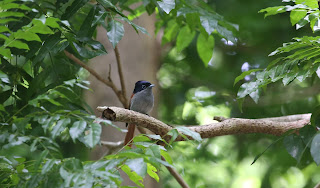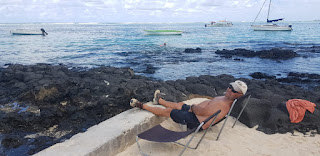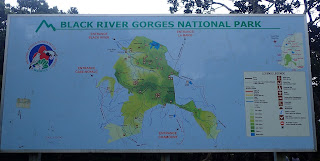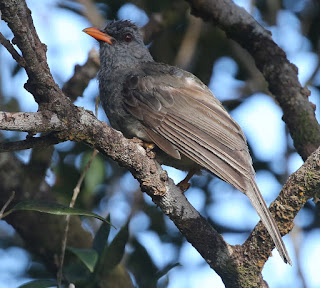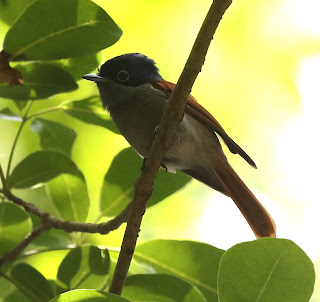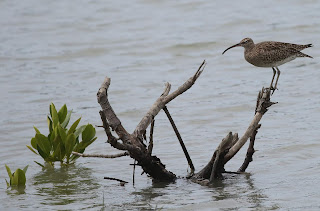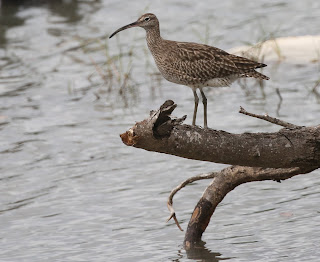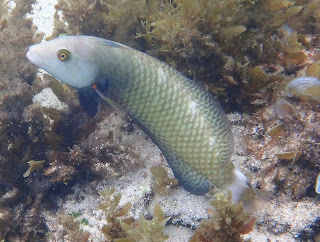You can go right out onto the rocks,
but you will get hit with spray!
I found it better viewing slightly further back.
I must admit I didn't do my homework on this one. Islands are not usually great locations for sea-watching, so I didn't really look at any locations until by pure chance, we visited La Roche qui Pleure, which is a local scenic spot on the south coast,
Drive to the car park & turn left down a track with a barrier across stopping cars from entering. After 200 metres go down into the dell & follow the path up on to the coast. There are quite a few tourists here taking photos etc. What immediately strikes you is that you are looking into deep water. We were there in the afternoons & the light was superb for sea-watching (between the heavy showers of rain). On my first visit, there was a constant procession of Wedge tailed Shearwaters, but we only stayed for twenty minutes. We vowed to come back as the place has lots of potential.
On our next two visits we saw both Round Island, Barau's, & Bulwer's Petrels with one Kermadec Petrel thrown in for good measure! The petrels are just too far out to obtain any photos with my 100-400 mm Canon lens, but one does get fairly good views from the telescope. I set the magnification on 40x for most of my viewing.
Birds are not always present: on our third visit we didn't see a thing for the first one & half hours & we were just going to pack it in when it all started. The variety is not great but the specialties are there. We only visited because the Mauritian Wildlife Foundation wanted to charge us a whopping 800 pounds sterling for a three hour visit around Round Island. I know the money goes to a good cause, but really guys?
Round Island Petrel: all the birds I saw were dark morphs. It is the size of a Barau's Petrel, but the wings are much longer & more slender, with pointed wing tips. It is overall dark grey, looking mat black in some lights. The biggest & easiest ID feature is the silvery grey central under-wing panel which gives it the look of a Sooty Shearwater (but different flight pattern of course)! The under-body was mottled dark grey, but some light mottling could be discerned on all individuals, although this varied a little.
There is a possibility of hybrids here, particularly breeding with both Kermadec & Herald Petrels. However, all the birds I saw were classic dark morph Round Island Petrels.
My companion Erik, saw at least one light morph, while I was with him, but I couldn't pick it out among the feeding frenzy of over 100+ Wedge tailed Shearwaters
Barau's Petrel: this was a big surprise for me! I knew the only known breeding grounds are on relatively close by Reunion, but didn't realise it was possible just offshore from Mauritius. On both occasions that I did a proper two-three hour sea-watch I saw this species easily.
It is a typical Pterodroma keeping low over the waves in the light conditions when we were present. Medium grey above, colour changing from dark to mid grey dependent upon light conditions. Underwings white with black tipped primaries & dark edgings on both fore & hind wings. Underparts startlingly white. Dark grey head patch comes lower than eye, giving a almost Peregrine like look! It has a relatively long, tapering tail which is same colour as rest of upper-parts. Unmistakable within range.
Kermadec Petrel: this is a species I have seen quite a few times around the world. It is a large, stocky petrel, much larger then Barau's & has a much bigger weight. The wings are broad, particularly at the base. from above it is all dark rather uniform grey, but the white primary wing flashes can be seen at even great distance. The tail is also dark grey & short & broad, it never looks tapering or pointed. The underparts were mottled dark grey. This individual was an intermediate to dark morph. Underwings are all dark, but one can just make out the primary wing flashes on the under-wing. The head & throat were dark grey. The one bird I saw here was keeping low & weaving over the sea. It really does resemble a Skua in many ways & so is quite distinctive even though its plumage isn't! If that makes sense?
Bulwer's Petrel: seen on both proper sea watching afternoons. These birds are strange! I have seen Bulwer's Petrel in quite a few corners of the world & these birds were different. For a start they are quite large, larger than a more normal Bulwer's. The upper-wing panel was pale & very noticeable. The head is quite bulbous & the down pointing bill is large & thick! The flight was normal Bulwer's. They were not a stocky or as large as Jouanin's Petrel (a species I am quite familiar with). All three individuals I saw, were identical.I think there may be a lot more to learn about these birds!
There is a lot of potential for further sew-watching both off this location & other locations in northern Mauritius. Presumably the headlands (which we didn't visit) closer to Round & other Islands could be equally good? I would be interested in hearing about further sea-watching efforts from Mauritius.
Round Island Petrel: all the birds I saw were dark morphs. It is the size of a Barau's Petrel, but the wings are much longer & more slender, with pointed wing tips. It is overall dark grey, looking mat black in some lights. The biggest & easiest ID feature is the silvery grey central under-wing panel which gives it the look of a Sooty Shearwater (but different flight pattern of course)! The under-body was mottled dark grey, but some light mottling could be discerned on all individuals, although this varied a little.
There is a possibility of hybrids here, particularly breeding with both Kermadec & Herald Petrels. However, all the birds I saw were classic dark morph Round Island Petrels.
My companion Erik, saw at least one light morph, while I was with him, but I couldn't pick it out among the feeding frenzy of over 100+ Wedge tailed Shearwaters
Barau's Petrel: this was a big surprise for me! I knew the only known breeding grounds are on relatively close by Reunion, but didn't realise it was possible just offshore from Mauritius. On both occasions that I did a proper two-three hour sea-watch I saw this species easily.
It is a typical Pterodroma keeping low over the waves in the light conditions when we were present. Medium grey above, colour changing from dark to mid grey dependent upon light conditions. Underwings white with black tipped primaries & dark edgings on both fore & hind wings. Underparts startlingly white. Dark grey head patch comes lower than eye, giving a almost Peregrine like look! It has a relatively long, tapering tail which is same colour as rest of upper-parts. Unmistakable within range.
Kermadec Petrel: this is a species I have seen quite a few times around the world. It is a large, stocky petrel, much larger then Barau's & has a much bigger weight. The wings are broad, particularly at the base. from above it is all dark rather uniform grey, but the white primary wing flashes can be seen at even great distance. The tail is also dark grey & short & broad, it never looks tapering or pointed. The underparts were mottled dark grey. This individual was an intermediate to dark morph. Underwings are all dark, but one can just make out the primary wing flashes on the under-wing. The head & throat were dark grey. The one bird I saw here was keeping low & weaving over the sea. It really does resemble a Skua in many ways & so is quite distinctive even though its plumage isn't! If that makes sense?
Bulwer's Petrel: seen on both proper sea watching afternoons. These birds are strange! I have seen Bulwer's Petrel in quite a few corners of the world & these birds were different. For a start they are quite large, larger than a more normal Bulwer's. The upper-wing panel was pale & very noticeable. The head is quite bulbous & the down pointing bill is large & thick! The flight was normal Bulwer's. They were not a stocky or as large as Jouanin's Petrel (a species I am quite familiar with). All three individuals I saw, were identical.I think there may be a lot more to learn about these birds!
There is a lot of potential for further sew-watching both off this location & other locations in northern Mauritius. Presumably the headlands (which we didn't visit) closer to Round & other Islands could be equally good? I would be interested in hearing about further sea-watching efforts from Mauritius.


